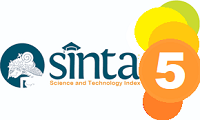Rasio Finansial terhadap Efisiensi Perusahaan Manufaktur di Bursa Efek Indonesia 2017-2021
DOI:
https://doi.org/10.35134/ekobistek.v11i2.348Keywords:
firm efficiency, tangibility, liquidity, productivity, profitabilityAbstract
In Indonesia, nowadays, there are lots of companies that are rapidly growing and engaged in various fields. It caused increasingly fierce competition between companies. Company effectiveness is needed so that companies can maximize existing resources and be able to compete with competitors. A company needs to be efficient. Otherwise, the company will face threats from foreign and local competitors seriously. It will affect the company's income level into bankruptcy. Financial ratios are the factor that is entirely calculated in the company's efficiency. The financial ratios commonly used are tangibility, leverage, liquiditty, productivity, and profitability. This study aims to determine the effect of Tangibility, Leverage, Liquiditty, Productivity, and Profitability on Firm efficiency in manufacturing companies listed on the Indonesia Stock Exchange from 2017-2021. The data used in this study is panel data. The data was obtained from the Indonesia Stock Exchange website. The analysis includes the determination of the panel data regression model, the F test, the Goodness of Fit test (Adjusted R2), the Multiple Linear Regression Test, and the Hypothesis Test. The results showed that tangibility, leverage, and liquiditty did not affect firm efficiency. Meanwhile, productivity and profitability have a positive and significant relationship to a firm's efficiency. The results of this study can be used for companies as a reference to improve the level of efficiency, and also for investors can be used as a reference in choosing companies to invest in.
References
Alpi, M. F., & Gunawan, A. (2018). Pengaruh current ratio dan total assets turnover terhadap return on assets pada perusahaan plastik dan kemasan. Jurnal Riset Akuntansi Aksioma, 17(2), 1-36. https://doi.org/10.29303/aksioma.v17i2.43
Rumerung, Y. H., & Alexander, S. W. (2019). Analisis Kinerja Keuangan Pada Perusahaan Pertambangan YAng terdaftar di Bursa Efek Indonesia. Jurnal EMBA: Jurnal riset Ekonomi, Manajemen, Bisnis dan Akuntansi, 7(3). https://doi.org/10.35794/emba.v7i3.24970
Handayani, W., & Hilmansyah, I. A. (2022). Pengaruh Tata Letak Produksi Terhadap Efisiensi Usaha dan Daya Saing UD. Barokah Lamongan. Jurnal Ekonomi dan Bisnis Dharma Andalas, 24(1), 227-241. https://doi.org/10.47233/jebd.v24i1.319
Hi, J., Nurwahidaha, J., Hidayat, A. N., & Widodo, E. (2021). ANALISIS PENGARUH FAKTOR RASIO INDEKS LQ45 TERHADAP HARGA INDEKS LQ45 TAHUN 2016-2018. NUSANTARA: Jurnal Ilmu Pengetahuan Sosial, 8(8), 2725-2734. http://dx.doi.org/10.31604/jips.v8i8.2021.2725-2734
Sari, D. P., & Setiawan, M. A. (2021). Pengaruh Tangibility, Pertumbuhan Perusahaan, Resiko Bisnis dan Profitabilitas terhadap Kebijakan Hutang. JURNAL EKSPLORASI AKUNTANSI, 3(2), 384–399. https://doi.org/10.24036/jea.v3i2.367
Jihadi, M., VILANTIKA, E., HASHEMI, S. M., Arifin, Z., BACHTIAR, Y., & Sholichah, F. (2021). The effect of liquiditty, leverage, and profitability on firm value: Empirical evidence from Indonesia. The Journal of Asian Finance, Economics and Business, 8(3), 423-431. https://doi.org/10.13106/jafeb.2021.vol8.no3.0423
Hidayat, A. T., & Fitria, E. F. (2018). Pengaruh Capital Intensity, Inventory Intensity, Profitabilitas dan Leverage Terhadap Agresivitas Pajak. Eksis: Jurnal Riset Ekonomi Dan Bisnis, 13(2), 157-168. https://doi.org/10.26533/eksis.v13i2.289
Saputri, L., & Asrori, A. (2019). The effect of leverage, liquiditty and profitability on financial distress with the effectiveness of the audit committee as a moderating variable. Accounting Analysis Journal, 8(1), 38-44. https://doi.org/10.15294/aaj.v8i1.25887
Seth, H., Chadha, S., Ruparel, N., Arora, P. K., & Sharma, S. K. (2020). Assessing working capital management efficiency of Indian manufacturing exporters. Managerial Finance. https://doi.org/10.1108/MF-02-2019-0076
Vu, Q., & Tran, T. Q. (2021). Government financial support and firm productivity in Vietnam. Finance research letters, 40, 101667. https://doi.org/10.1016/j.frl.2020.101667
Anggry, A., & Krisnaningsih, S. D. (2021). ALIH TEKNOLOGI DALAM UPAYA MENINGKATKAN PRODUKTIVITAS DAN PROFITABILITAS USAHA RUMAHAN “NAURAH CAKES”. Jurnal Pengabdian Masyarakat Polmanbabel, 1(02), 49-56. https://doi.org/10.33504/dulang.v1i02.189
Marlius, D., & Pebriyana, S. (2020). Analisis Rasio Profitabilitas Pada Pt. Bank Pembangunan Daerah Sumatera Barat Cabang Utama Padang. https://doi.org/10.31219/osf.io/7gnd5
Tania, J. (2022). Rasio Keuangan dan Efisiensi pada Perusahaan Sektor Energi yang Terdaftar di BEI. Monex: Journal of Accounting Research, 11(2), 202-213. http://dx.doi.org/10.30591/monex.v11i2.3619
Prabowo, R., & Sutanto, A. (2019). Analisis Pengaruh Struktur Modal, dan Likuiditas terhadap Profitabilitas pada Perusahaan Sektor Otomotif di indonesia. Jurnal Samudra Ekonomi Dan Bisnis, 10(1), 1-11. https://doi.org/10.33059/jseb.v10i1.1120
Alarussi, A. S. A. (2021). Financial ratios and efficiency in Malaysian listed companies. Asian Journal of Economics and Banking. https://doi.org/10.1108/AJEB-06-2020-0014
Almaqtari, F. A., Al‐Homaidi, E. A., Tabash, M. I., & Farhan, N. H. (2019). The determinants of profitability of Indian commercial banks: A panel data approach. International Journal of Finance & Economics, 24(1), 168-185. https://doi.org/10.1002/ijfe.1655
Fermantiningrum, E. (2019). Pengaruh Rasio Keuangan Terhadap Likuiditas Saham Pada Sektor Perbankan di Bursa Efek Indonesia Periode 2008-2012. Jurnal Ilmiah Manajemen dan Bisnis, 5(1), 463659. https://doi.org/10.22441/jimb.v5i1.5623
Downloads
Published
How to Cite
Issue
Section
License
Copyright (c) 2022 Jurnal Ekobistek

This work is licensed under a Creative Commons Attribution 4.0 International License.





